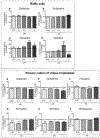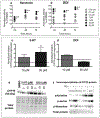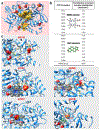Serotonin and serotonin reuptake inhibitors alter placental aromatase
- PMID: 31509772
- PMCID: PMC7939054
- DOI: 10.1016/j.jsbmb.2019.105470
Serotonin and serotonin reuptake inhibitors alter placental aromatase
Abstract
Serotonin reuptake inhibitors (SRIs) are currently the main molecules prescribed to pregnant women that suffer from depression. Placental cells are exposed to SRIs via maternal blood, and we have previously shown that SRIs alter feto-placental steroidogenesis in an in vitro co-culture model. More specifically, serotonin (5-HT) regulates the estrogen biosynthetic enzyme aromatase (cytochrome P450 19; CYP19), which is disrupted by fluoxetine and its active metabolite norfluoxetine in BeWo choriocarcinoma cells. Based on molecular simulations, the present study illustrates that the SRIs fluoxetine, norfluoxetine, paroxetine, sertraline, citalopram and venlafaxine exhibit binding affinity for the active-site pocket of CYP19, suggesting potential competitive inhibition. Using BeWo cells and primary villous trophoblast cells isolated from normal term placentas, we compared the effects of the SRIs on CYP19 activity. We observed that paroxetine and sertraline induce aromatase activity in BeWo cells, while venlafaxine, fluoxetine, paroxetine and sertraline decrease aromatase activity in primary villous trophoblast. The effects of paroxetine and sertraline in primary villous trophoblasts were observed at the lower doses tested. We also showed that 5-HT and the 5-HT2A receptor agonist 2,5-dimethoxy-4-iodoamphetamine (DOI) induced CYP19 activity. An increase in phosphorylation of serine and tyrosine and a decrease in threonine phosphorylation of CYP19 was also associated with DOI treatment. Our results contribute to better understanding how 5-HT and SRIs interact with CYP19 and may affect estrogen production. Moreover, this study suggests that alteration of placental 5-HT levels due to depression and/or SRI treatment during pregnancy may be associated with disruption of placental estrogen production.
Keywords: Antidepressant; CYP19; Estrogen; Phosphorylation; Trophoblast.
Copyright © 2019 Elsevier Ltd. All rights reserved.
Conflict of interest statement
Figures




Similar articles
-
Fluoxetine and its active metabolite norfluoxetine disrupt estrogen synthesis in a co-culture model of the feto-placental unit.Mol Cell Endocrinol. 2017 Feb 15;442:32-39. doi: 10.1016/j.mce.2016.11.021. Epub 2016 Nov 24. Mol Cell Endocrinol. 2017. PMID: 27890559
-
Effects of selective serotonin-reuptake inhibitors (SSRIs) on human villous trophoblasts syncytialization.Toxicol Appl Pharmacol. 2018 Jun 15;349:8-20. doi: 10.1016/j.taap.2018.04.018. Epub 2018 Apr 19. Toxicol Appl Pharmacol. 2018. PMID: 29679653
-
Stimulation of serotonergic 5-HT2A receptor signaling increases placental aromatase (CYP19) activity and expression in BeWo and JEG-3 human choriocarcinoma cells.Placenta. 2011 Sep;32(9):651-656. doi: 10.1016/j.placenta.2011.06.003. Epub 2011 Jun 24. Placenta. 2011. PMID: 21703684
-
Comparison of the effects of antidepressants and their metabolites on reuptake of biogenic amines and on receptor binding.Cell Mol Neurobiol. 1999 Aug;19(4):467-89. doi: 10.1023/a:1006986824213. Cell Mol Neurobiol. 1999. PMID: 10379421 Free PMC article. Review.
-
Clinically relevant pharmacology of selective serotonin reuptake inhibitors. An overview with emphasis on pharmacokinetics and effects on oxidative drug metabolism.Clin Pharmacokinet. 1997;32 Suppl 1:1-21. doi: 10.2165/00003088-199700321-00003. Clin Pharmacokinet. 1997. PMID: 9068931 Review.
Cited by
-
From placenta to the foetus: a systematic review of in vitro models of stress- and inflammation-induced depression in pregnancy.Mol Psychiatry. 2025 Apr;30(4):1689-1707. doi: 10.1038/s41380-024-02866-1. Epub 2024 Dec 5. Mol Psychiatry. 2025. PMID: 39639175 Free PMC article.
-
Gestational Factors throughout Fetal Neurodevelopment: The Serotonin Link.Int J Mol Sci. 2020 Aug 14;21(16):5850. doi: 10.3390/ijms21165850. Int J Mol Sci. 2020. PMID: 32824000 Free PMC article. Review.
-
Serotonin system in the human placenta - the knowns and unknowns.Front Endocrinol (Lausanne). 2022 Dec 1;13:1061317. doi: 10.3389/fendo.2022.1061317. eCollection 2022. Front Endocrinol (Lausanne). 2022. PMID: 36531448 Free PMC article. Review.
-
Profiling placental DNA methylation associated with maternal SSRI treatment during pregnancy.Sci Rep. 2022 Dec 30;12(1):22576. doi: 10.1038/s41598-022-26071-8. Sci Rep. 2022. PMID: 36585414 Free PMC article.
-
A Cohort Study to Evaluate Genetic Predictors of Aromatase Inhibitor Musculoskeletal Symptoms: Results from ECOG-ACRIN E1Z11.Clin Cancer Res. 2024 Jul 1;30(13):2709-2718. doi: 10.1158/1078-0432.CCR-23-2137. Clin Cancer Res. 2024. PMID: 38640040 Free PMC article.
References
-
- Holden C, Sex and the suffering brain, Science 308 (2005) 1574–1577. - PubMed
-
- Marcus SM, Kerber KB, Rush AJ, Wisniewski SR, Nierenberg A, Balasubramani GK, Ritz L, Kornstein S, Young EA, Trivedi MH, Sex differences in depression symptoms in treatment-seeking adults: confirmatory analyses from the Sequenced Treatment Alternatives to Relieve Depression study, Comprehensive Psychiatry 49(3) (2008) 238–246. - PMC - PubMed
-
- Bennett H, Einarson A, Taddio A, Koren G, Einarson T, Prevalence of depression during pregnancy : systematic review, Obstetrics & Gynecology 103(4) (2004) 698–709. - PubMed
Publication types
MeSH terms
Substances
Grants and funding
LinkOut - more resources
Full Text Sources

